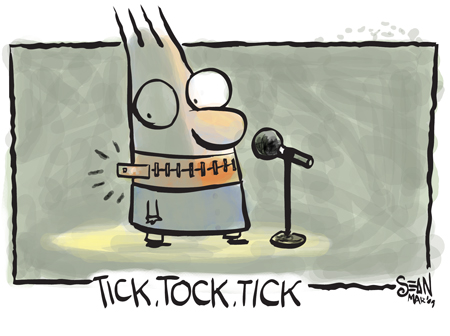
I've seen it at presentation after presentation.
A speaker will say something funny, and the audience will laugh.
Not some pathetic laugh, but a nice big laugh will erupt from the crowd.
And the speaker continues speaking, almost cutting out the sound of the laughter.
And if you're a speaker, all you're doing is being rude.
When an audience laughs, they're having a “conversation” with you.
You've said something. They're saying “something” back.
It's not polite to go on to your next slide—if you know what I mean.
You have to wait. You have to listen to the audience. And only when the audience stops laughing, should you move on.
Notice what happens in a comedy series.
Pick any comedy series, and you'll notice something. The talent waits. They get the audience to laugh. Then they zip it up. They wait. And if you consider that most comedies have dozens of laughs in every episode, that's a lot of zipping up and waiting to do.
And the reason they zip it up and wait is because they're professionals.
They know that any “presentation” is a two-way street.
That by simply moving on to your next slide is not a matter of efficiency. It's a matter of boorishness. And ignorance.
And that if you're truly a great speaker, you'll zip it up.
And wait!

Sean that is so “spot on”… I think the sentence ‘any “presentation” is a two-way street’ says it all. I’ve been doing presentations in one form or another for years and I learnt very early on that the best presentation is one where the ‘audience’ responds, and what better response is there than laughter?
So true. In acting we learn to find the timing in when to pause. If you try to talk over the laughter in essence all you do is train your audience not to laugh. Not good. Because response is a great indicator of how you’re doing.
On that note it’s important to point out the not all audiences react the same. Some may laugh at a particular line. Where another audience is completely quiet. But they’re still enjoying themselves. The trick is to keep the audience engaged. And you do that by allowing them to respond how they see fit.
@Dave: When an audience doesn’t laugh where they’re ‘supposed to’, I also use it as an early warning system. That means they’re a tougher audience, or it’s the wrong time of day etc. So I use it as a warning system and tweak my presentation just a little bit to take that factor into consideration.
Hey Sean,
Great advice as usual.
And I love the cartoon.
thanks for that